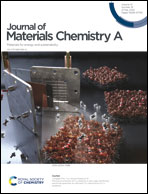PVP derived nitrogen-doped porous carbon integrated with polyindole: nano/microspheres assembled by emulsion polymerization for asymmetric supercapacitors†
Abstract
The introduction of a carbon scaffold with excellent electrical conductivity is a satisfactory strategy to improve the poor energy storage performance of polyindole (PIn). Herein, a series of PIn integrated with nitrogen-doped porous carbon (NPC) materials are synthesized via facile emulsion polymerization. The morphology, composition and elemental state of as-prepared nano/microspheres are investigated by field emission scanning electron microscopy, Fourier transform infrared spectroscopy, X-ray diffraction spectroscopy and X-ray photoelectron spectroscopy. The supercapacitive performance is evaluated by cyclic voltammetry, galvanostatic charge–discharge and electrochemical impedance spectroscopy. It is shown that the morphology and size of NPC@PIn composites can be well-controlled by adjusting the contents of NPC. The as-prepared NPC@PIn based electrode has a high specific capacitance of 286.2 F g−1 at 0.5 A g−1 and satisfactory cycling stability (88.9% specific capacitance retention after 3000 charge/discharge cycles) in 1.0 M H2SO4 electrolyte. Furthermore, with a broad voltage window of 1.5 V, the as-assembled NPC@PIn-2//Ti3C2Tx asymmetric supercapacitor achieves a high specific energy of 30.4 W h kg−1 at a specific power of 750 W kg−1 and excellent cycling stability (87.8% retention after 3000 cycles). The above results demonstrate that construction of carbon-supported PIn-based electrodes is an effective strategy to improve the application in energy storage.



 Please wait while we load your content...
Please wait while we load your content...